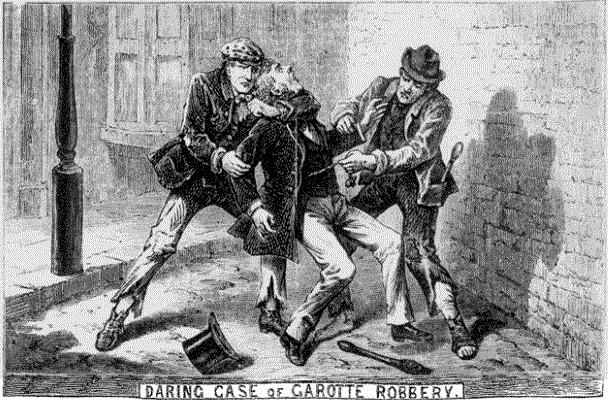The Garrotting Fears of Victorian London
In the 19th Century, London emerged as the world’s largest city, its growth driven by railways, industry, and immigration. The cessation of convict transportation to Australia further contributed to the city’s population surge, including an increase in criminals. This led to the rise of a feared new type of criminal: garrotters. Originally, garrotting referred to strangulation with a device or rope, but it came to be associated with a type of mugging where the attacker used their arm to strangle the victim while an accomplice robbed them.
As reports of garrotting proliferated, social commentators warned of dangerous “no-go” areas in London, echoing contemporary concerns about crime. This moral panic was fueled by a media frenzy, similar to other moral panics throughout history, such as the belief in the widespread satanic abuse of children. While there were indeed more criminals on the streets due to the end of transportation, much of the fear surrounding garrotting was exaggerated. The new parole system, which allowed prisoners to be released before completing their sentences, also contributed to the rise in reported incidents.
Satirical publications and advertisements capitalized on the fear by promoting anti-garrotting devices. Despite the media hype, crime statistics from the 1850s and 1860s showed that violent crime was relatively low, with most offences being petty theft. The formation of the Metropolitan Police Force in 1829 and the installation of gas lamps contributed to a reduction in crime rates.
The Times newspaper played a significant role in escalating the panic by publishing numerous editorials blaming the legal system and advocating for the reintroduction of transportation. The press portrayed criminals as a distinct, irredeemable class, further inflaming public fear. In late 1862, an MP’s garrotting incident revived the panic and led to a surge in both genuine and humorous anti-garrotting products.
The Royal Commission on Penal Servitude and Transportation was established in 1862 to review the penal system. The Garrotter Act of 1863 reinstated flogging for violent robbery convictions, and subsequent legislation mandated longer prison terms and stricter monitoring of released prisoners. The intensified laws and police measures eventually diminished the garrotting panic, although similar moral panics would continue to arise in the future.


Pingback: sans ordonnance kamagra pharmacie a paris
Pingback: cheapest buy enclomiphene generic canada no prescription
Pingback: purchase androxal usa cheap
Pingback: buy flexeril cyclobenzaprine uk meds
Pingback: cheapest buy dutasteride cheap sale
Pingback: online prescription for gabapentin
Pingback: fildena generic canada
Pingback: buy itraconazole cheap australia
Pingback: discount online staxyn
Pingback: buying avodart australia suppliers
Pingback: online order xifaxan generic information
Pingback: buy rifaximin where to purchase
Pingback: kamagra australský legální dovoz